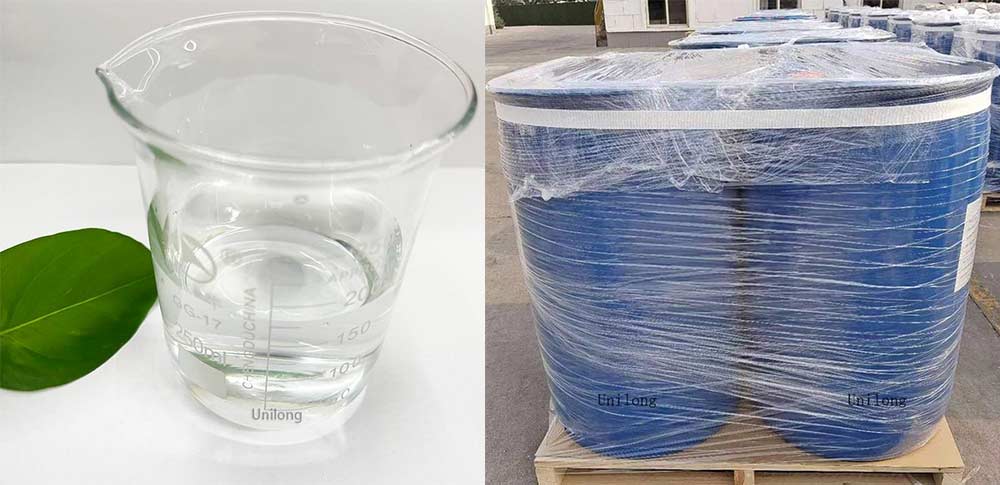Titanium tetraisopropanolate (Tetraisopropyl Titanate), CAS 546-68-9, is an important organotitanium compound and is widely used in industries, materials science and other fields. Now let’s take a look at this product.
Basic information
| Project | Content |
| Chinese name | 钛酸四异丙酯、四异丙氧基钛 |
| English name | Titanium tetraisopropanolate; Tetraisopropyl Titanate; Titaniumiv isopropoxide; Titanium(IV) isopropoxide |
| CAS number | 546-68-9 |
| MF | C12H28O4Ti |
| MW | 284.22 |
| Molecular structure | The central titanium atom (Ti⁴⁺) is bound to four isopropoxy groups (-OCH (CH₃)₂) through coordination bonds, and it belongs to the titanate compound class |
Core physicochemical properties
Appearance and condition: At room temperature, it is a colorless to pale yellow transparent liquid with a pungent odor (similar to alcohols or ethers).
Solubility: Readily soluble in organic solvents, reacts vigorously with water – it will rapidly hydrolyze to form titanium dioxide (TiO₂) precipitate and isopropyl alcohol ((CH₃)₂CHOH), so it should be stored and used in a dry environment.
Boiling point and melting point: The boiling point is approximately 220-224℃ (at normal pressure), and the melting point is about 14℃ (it may solidify below 14℃ and can remelt upon heating).
Stability: Sensitive to air, it readily absorbs moisture from the air and undergoes hydrolysis. It may decompose at high temperatures and release irritating gases.
Main uses
The application of titanium tetraisopropanolate is highly dependent on its three core characteristics: easy hydrolysis to form titanium dioxide, good organic compatibility, and catalytic activity. Titanium tetraisopropanolate is widely used in multiple fields such as material synthesis, industrial catalysis, coatings, and adhesives. The specific application scenarios are as follows
I. Field of Materials Synthesis: Core as a “titanium dioxide precursor”
This is the main application of titaniumiv Isopropox IDE. By taking advantage of its hydrolysis reaction, titanium dioxide (TiO₂) materials of different forms and properties can be precisely prepared to meet diverse demands.
Preparation of nano-titanium dioxide
Titanium(IV) isopropoxide is dissolved in an organic solvent through the “sol-gel method”, and then slowly hydrolyzed under controllable conditions (adjusting pH, temperature, andhydrolysis rate) to form a uniform “sol”. After further drying and calcination, nano-scale titanium dioxide powder or film is obtained. This type of nano-tio ₂ features a high specific surface area and excellent photocatalytic activity, and can be used for:
Photocatalytic materials: treating sewage (degrading organic pollutants), air purification (decomposing formaldehyde and VOCs);
Sunscreen cosmetics: Titanium tetraisopropanolate as a physical sunscreen agent (nano-tio ₂ can reflect ultraviolet rays, has high transparency and does not turn white);
Optoelectronic materials: Titanium tetraisopropanolate for preparing the light-absorbing layer of solar cells and the functional thin film of liquid crystal display devices.
Ceramic and glass functional coatings
Titanium(IV) isopropoxide is compounded with other additives (such as silane coupling agents) to form a coating solution, which is then sprayed or dipped onto the surface of ceramics and glass. After heating and curing, the TiO₂ generated by the hydrolysis of tetraisopropyl titanate forms a transparent coating with high hardness, high temperature resistance and wear resistance, which can:
Enhance the stain resistance of ceramic tableware and bathroom fixtures (reduce the adhesion of oil stains);
Enhance the scratch resistance of glass (such as mobile phone screen protection glass, car glass);
Endow glass with a “self-cleaning” function (utilizing the photocatalytic property of TiO₂ to decompose surface dust and stains).
Synthesis of titanium-based functional materials
As a titanium source, it reacts in synergy with other metal salts (such as aluminum salts and zirconium salts) to prepare titanium-aluminum composite oxides, titanium-zirconium solid solutions and other materials, which are used in high-temperature ceramics and catalyst carriers (to enhance the stability and specific surface area of the carriers).
II. Industrial Catalysis Field: Efficient catalytic organic reactions
Relying on the empty d orbital coordination ability of the central titanium atom (Ti⁴⁺), Titanium IV Isopropox IDE cas 546-68-9 is an excellent catalyst for a variety of organic reactions, especially suitable for scenarios that require high selectivity and low side reactions:
Catalysts for esterification and transesterification reactions
When synthesizing polyester resins (such as PET and PBT), replacing traditional acidic catalysts (such as sulfuric acid) can accelerate the esterification reaction between carboxylic acids and alcohols, reduce by-products (such as dehydration of alcohols), and the catalyst is easy to separate from the products, thereby improving the purity of the resin.
Titaniumiv isopropoxide cas 546-68-9 catalyzes transesterification reactions (such as the reaction of lower esters with higher alcohols to form higher esters) in the synthesis of flavors and fragrances and pharmaceutical intermediates, enhancing reaction efficiency and product yield.
Selective catalysis in organic synthesis
Titanium tetraisopropanolate, as the core of the “titanium catalytic system” (such as in combination with tartrate esters), is used in asymmetric epoxidation reactions (for the synthesis of chiral epoxides, key pharmaceutical intermediates);
titanium(IV) isopropoxide catalyzes aldol condensation reactions and precisely controls the structure of the product, making it suitable for the fine chemical industry.
III. Coatings and Adhesives Field: Enhancing the interface performance of materials
By taking advantage of its “organic-inorganic bridge” feature (one end bonded with inorganic materials and the other end cross-linked with organic materials), the adhesion and durability of coatings and adhesives can be improved:
Coatings industry: Crosslinking agents and adhesion promoters
Adding a small amount of tetraisopropyl titanate to acrylic coatings and polyurethane coatings, the isopropoxy group can react with the hydroxyl (-OH) and carboxyl (-COOH) groups in the coating to form a cross-linked structure, thereby enhancing the weather resistance (UV aging resistance), water resistance and hardness of the coating.
Primer for metal substrates such as steel and aluminum alloy, promoting the adhesion of the coating to the metal surface and reducing coating peeling and rusting.
Adhesive industry: Enhance bonding strength
Titanium tetraisopropanolate is used as a “coupling agent” in epoxy resin adhesives and silicone adhesives. One end reacts with the hydroxyl groups on the surface of inorganic substrates such as metals and ceramics, and the other end cross-links with the organic polymer chains of the adhesives. Significantly enhance the bonding strength and moisture and heat resistance of adhesives to inorganic materials (such as for packaging and bonding of electronic components).
IV. Other special purposes
Metal surface treatment
Titanium tetraisopropanolate is used for surface passivation treatment of aluminum and magnesium alloys. The TiO₂ generated by the hydrolysis of tetraisopropyl titanate forms a composite passivation film with the oxide on the metal surface, enhancing the corrosion resistance of the metal (replacing the traditional chromate passivation and being more environmentally friendly).
Preparation of optical materials
By means of “chemical vapor deposition (CVD)” technology, the vapor of tetraisopropyl titanate is introduced into the reaction chamber, where it decomposes on the surface of the substrate (such as quartz glass) to form TiO₂ films, which are used to prepare optical filters and anti-reflective coatings (for regulating light transmittance).
Textile industry: Functional finishing agents
Titanium(IV) isopropoxide reacts with the hydroxyl groups on the surface of textile fibers to form a TiO₂ film on the fiber surface, endowing the fabric with antibacterial properties (utilizing the photocatalytic bactericidal effect of TiO₂) and UV resistance (such as in outdoor sun-protective fabrics).
Post time: Sep-18-2025




